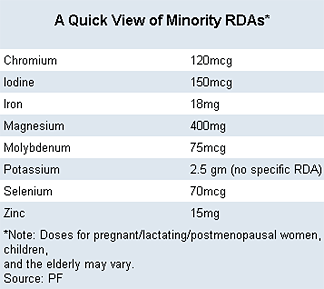Magnesium plays a crucial role in activating between 80 to 100 enzymes in the body and is key in general nerve and muscle function. “It helps maintain the integrity of cell membranes and is critical to proper heart function,” explains Ram Chaudhari, Ph. D., senior executive vice president, R&D, Fortitech, Schenectady, N.Y. Magnesium, which has a Recommended Daily Allowance (RDA) of 400mg, occurs naturally in milk and vegetables, but many Americans do not consume sufficient quantities.

Different magnesium forms are required for various foods and beverages. “If you use magnesium oxide in soy-based products, it will not function properly because it interacts with soy protein and gives unacceptable flavor. However, it works well in whole milk or casein-based products. In another example, magnesium gluconate or magnesium phosphate would work better in beverages containing soy protein as an ingredient.

Minority Minerals
The increased interest in antioxidants has resulted in a greater demand for the essential trace mineral selenium, which protects cells against the effects of free radicals. Indirectly, selenium helps to “detoxify” the body of heavy, toxic metals—such as aluminum and mercury—and plays a significant role in the production of antibodies. However, “People shouldn't take megadoses of selenium—there are toxicity issues,” warns Chaudhari. Fortitech offers premixes of nutrient systems containing selenium in the form of sodium selenate and selenite.Zinc is involved in the functioning of more than 200 enzymes and is especially important in the immune response and also helps heal wounds and cuts. The World Health Organization's website claims that American adults receive only 8-10mg of zinc daily, less than the RDA of 15mg. It also notes that zinc lozenges can reduce the common cold from 7.6 to 4.4 days. Forms of zinc include zinc oxide, zinc sulfate and zinc gluconate. “In beverages, a soluble form such as zinc gluconate is a preferred choice. However, in milk-based products, zinc sulfate should be used, since zinc gluconate reacts to give an off-color,” says Chaudhari.
Interest also grows in chromium for its role in maintaining general well-being. Since it aids in glucose metabolism and helps regulate blood sugar, its popularity in products for diabetics has increased. In recent years, molybdenum has been spotlighted as a necessary component in many enzymes involved in the metabolic cycle's detoxifying mechanism. Potassium, essential in regulating the heartbeat and maintaining electrolyte balance, also has become popular.
Simply adding these and other nutrients to products is not recommended. Developers of fortified products must understand the intricacies of element interactions and their stability in finished products. Fortitech's team of food and nutritional scientists, food engineers and others, assist in designing nutrition systems. “Our customers don't have to worry about sourcing every separate ingredient. We become their partner, an extension of their product research team,” concludes Chaudhari.
For more information: Ram Chaudhari at 800-950-5156 • www.fortitech.com Fortitech • Write in 234